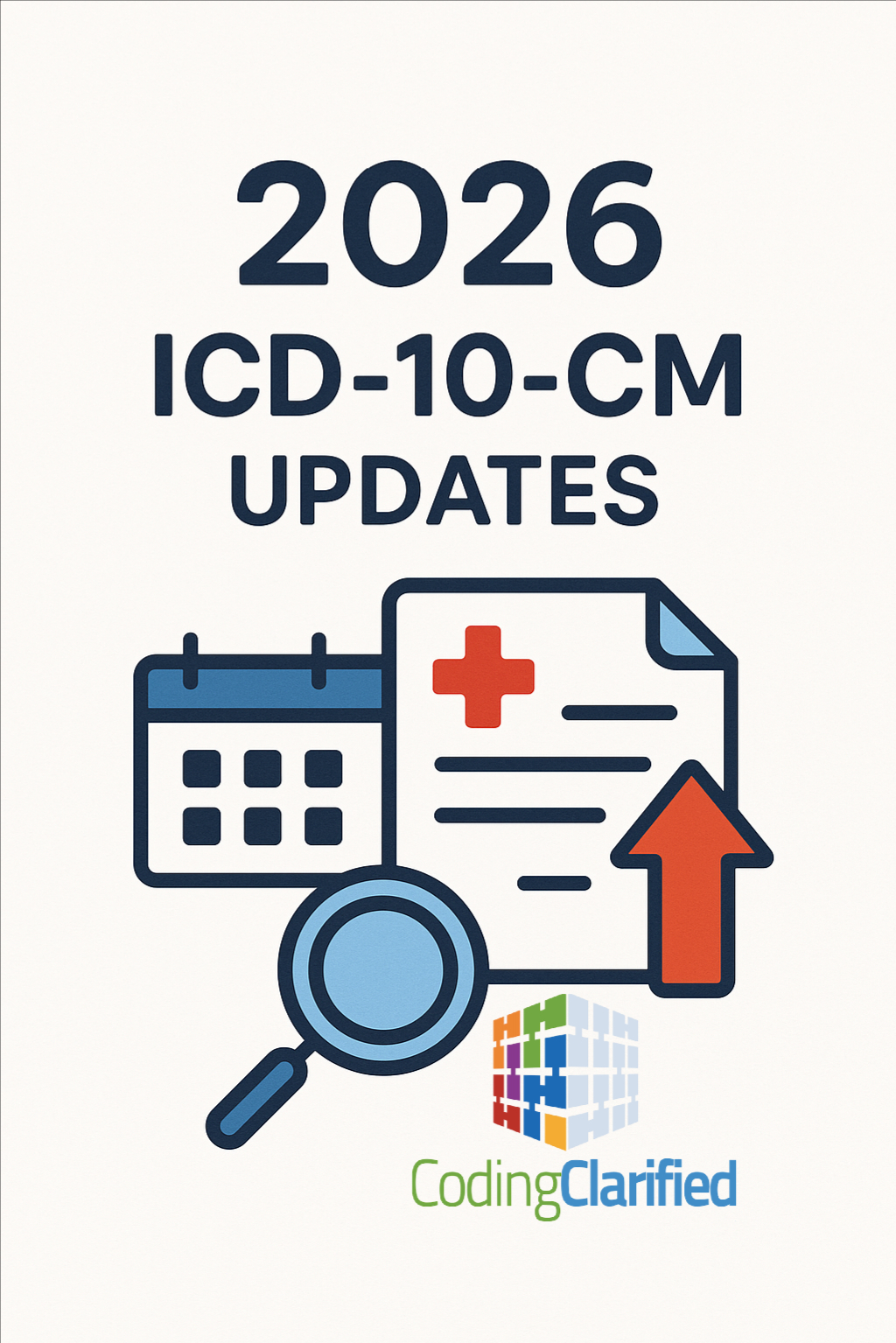Here’s a comprehensive breakdown of how the FY 2026 Inpatient Prospective Payment System (IPPS) Final Rule—published by CMS on August 4, 2025—and 2026 ICD-10-CM Updates are set to reshape medical coding, documentation, and reimbursement starting October 1, 2025 Centers for Medicare & Medicaid Services
Payment Rate Updates & Reimbursement Impacts
-
Overall increase of ~2.6% in inpatient operating payment rates for hospitals that are meaningful users of EHRs and participate in quality reporting programs. This stems from a 3.3% market basket increase minus a 0.7% productivity adjustment Centers for Medicare & Medicaid Services American Hospital Association.
-
Estimated $5 billion increase in total Medicare payments in FY 2026, including:
-
~$2 billion increase in uncompensated care payments to disproportionate share hospitals (DSHs);
-
~$192 million increase via New Technology Add-on Payments (NTAPs) Centers for Medicare & Medicaid ServicesAmerican Hospital Association.
-
-
Long-Term Care Hospitals (LTCHs) see a 2.7% base payment increase (reflecting a 3.4% basket minus 0.7%), with an overall
3% increase due to high-cost outlier adjustments ($72 million) Centers for Medicare & Medicaid Services
Coding Implication
-
NTAPs are significant—coding professionals must ensure accurate capture of related ICD-10-CM/PCS codes for approved technologies to secure additional payment. The finalized rule includes new NTAP designations with associated coding guidance American Hospital Association.
-
New MS-DRG assignments, including those for percutaneous coronary atherectomy, complex aortic arch procedures, and more, require updated coding workflows
MS-DRG Coding Changes & Documentation Requirements
-
Several new MS-DRGs finalized, such as:
-
Complex aortic arch procedures
-
Endovascular abdominal aorta and iliac branch procedures
-
Percutaneous coronary atherectomy with/without intraluminal device
-
-
Reassigned and deleted DRG codes, including removal of MS-DRGs 077–079 (hypertensive encephalopathy).
-
Classification adjustments and CC/MCC list updates: New diagnosis code titles and coding order for CC/MCC lists may shift how severity is captured in MS-DRG assignment Centers for Medicare & Medicaid Services American Hospital Association. Medical Coding DRG
Takeaway
-
Coders must familiarize themselves with new MS-DRGs, confirm mapping accuracy, update EHR templates, and ensure documentation precisely reflects new classifications to avoid revenue loss.
Quality Reporting, Value-Based Adjustments & Coding
-
Removal of several quality measures:
-
COVID-19 vaccination coverage measure
-
Hospital Commitment to Health Equity
-
Social Drivers of Health screening measures American College of Cardiology American Hospital Association.
-
-
Inclusion of Medicare Advantage patient data in supplementary quality programs like the Readmissions Reduction Program and VBP adjustments American Hospital Association
-
Notably, the Health Equity Adjustment is removed, potentially reducing payment modifications for equity-related factors American Hospital Association
Coding & Documentation Impact
-
Coders must ensure that coding reflects changed denominator/numerator definitions and captures Medicare Advantage remains well integrated.
-
Removing some equity-related measures underscores the importance of coding accuracy in remaining quality metrics to support reimbursement.
Transforming Episode Accountability Model (TEAM)
-
TEAM model finalized effective January 1, 2026—bundled payment model covering five surgical episodes, including CABG, total hip/knee arthroplasty, spinal fusion, major bowel procedures, and acute myocardial infarction American Hospital Association
-
Model includes updates to target pricing, risk adjustment, and quality measures. Notably, “voluntary opt-in” is allowed for hospitals already in BPCI Advanced or CJR models
-
CMS estimates estimated savings of $368 million over five years, with no significant change from FY 2025 projections
Implication for Coders & Documentation
-
Hospitals participating in TEAM need episode-level coding alignment, including consistency across inpatient and post-acute settings.
-
Accurate coding ensures integrity of bundled payment calculations and quality tracking over extended episodes.
Wage Index & Policy Safeguards
-
Low-wage index hospital policy is permanently discontinued as of FY 2026; however, a transitional safeguard applies for hospitals whose wage index would drop more than 9.75% versus FY 2024—they’ll be capped at 90.25% of their prior wage index
-
CMS continues applying standard rural, frontier, and state floor policies.
-
Payment adjustments for low-volume hospitals revert to original criteria starting October 1, 2025 (e.g., <200 discharges and >25 road miles from nearest subsection hospital)
Documentation & Billing Considerations
-
Accurate location and volume reporting remain critical—coders and billing staff must track discharges and site geography to determine eligibility for special payment adjustments.
Summary Table: Key Impacts for Medical Coding & Billing
| Area | Key Change | Implication for Coding/Documentation |
|---|---|---|
| Payment Rates & NTAPs | +2.6% update; ~$192M NTAP increase | Ensure NTAP codes are captured accurately to seize payment opportunities |
| MS-DRG Updates | New and deleted DRGs; CC/MCC changes | Update DRG assignment logic, EHR templates, and train coders |
| Quality Measures | Removal of equity and COVID-19 measures; MA data integration | Adjust performance reporting workflows; ensure MA coding |
| TEAM Model | Bundled payment for surgical episodes | Align episode‐based coding; maintain consistency post-acute |
| Wage Index Policy | Low-wage index phase-out; transitional cap | Verify wage index applicability through documentation |
| Low-Volume Policy | Reversion to standard criteria effective Oct 1, 2025 | Ensure correct documentation for eligibility |
Final Thoughts & Next Steps
-
Update coding resources, including codebooks, EHR templates, and DRG mapping logic, to reflect new MS-DRGs and NTAPs.
-
Train coding staff on new documentation requirements, especially for TEAM and MAS coding changes.
-
Coordinate with finance and compliance teams to track wage index adjustments, low-volume qualification, and NTAP supplemental payments.
-
Monitor published guidance, including Fact Sheets and supplemental files from CMS (e.g., Table 6P for new ICD-10 code guidance) Centers for Medicare & Medicaid Services.
-
Prepare for future webinars, such as the AHA’s coding-focused webinar held August 28, 2025, which covers MS-DRG changes, NTAPs, and coding implications American Hospital Association.
Bottom line: The FY 2026 IPPS Final Rule—with its payment increases, NTAP and DRG updates, TEAM model, and policy shifts—necessitates immediate updates to coding practices and documentation workflows. Aligning coding strategy now will safeguard compliance and position your facility to capture appropriate reimbursement.

